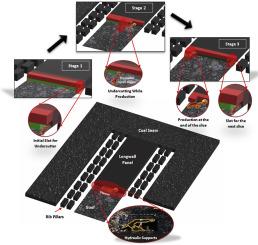当前位置:
X-MOL 学术
›
Int. J. Rock Mech. Min. Sci.
›
论文详情
Our official English website, www.x-mol.net, welcomes your feedback! (Note: you will need to create a separate account there.)
A new protective destressing technique in underground hard coal mining
International Journal of Rock Mechanics and Mining Sciences ( IF 7.2 ) Pub Date : 2020-06-01 , DOI: 10.1016/j.ijrmms.2020.104327 Ahmet Gunes Yardimci , Murat Karakus
International Journal of Rock Mechanics and Mining Sciences ( IF 7.2 ) Pub Date : 2020-06-01 , DOI: 10.1016/j.ijrmms.2020.104327 Ahmet Gunes Yardimci , Murat Karakus

|
Abstract Mining-induced stress accumulates in the immediate excavation borders to propose a risk of sudden and violent failure in the form of high-velocity ejection of rock fragments. Rockburst has become a major stability problem in hard rock mining as underground operations progress deeper down the earth. Likewise, coalburst exhibits a similar failure mechanism in relatively lower depths due to its low strength but high brittle characteristics. Commonly, stress manipulation techniques have been used to mitigate the risk of coalburst. Destress blasting offers a fast and significant decrease in stress concentration within the coal seam compared to the alternative destressing techniques. Stress accumulation shifts away from the excavation face and the fractured zone performs as a cushion between the overstressed region and the working panel. This study evaluates the conventional destressing techniques and proposes a novel method based on the simulations of an underground longwall mine located in New South Wales, Australia. Discontinuous rock media motivated the use of 3-dimensional Distinct Element Method (DEM) for modeling. Discrete Fracture Networks (DFN) were tested in terms of their capability to degrade the rock strength both on lab and field scale simulations. Later, an alternative method was developed to implement the fractured rock mass by eliminating the computational difficulties of DFN. Destress blasting was evaluated in terms of the location and roof stability measures. Despite its significance, blasting creates a violent and sudden impact on the rock mass, which is hard to control. Coalface undercutting was proposed as a new destressing technique. Undercut dimensions required for an effective stress-free cushion were studied in terms of numerical simulations. Later, a practical tool was developed by ‘Adaptive Neuro Fuzzy Inference System’ (ANFIS) in order to predict the effective undercut dimensions. Finally, some practical application guidelines were established for the new method.
中文翻译:

井下硬煤开采保护性去应力新工艺
摘要 采矿引起的应力在紧邻开挖边界处累积,以高速抛射碎石的形式提出突然和剧烈破坏的风险。随着地下作业深入地下,岩爆已成为硬岩开采中的主要稳定性问题。同样,煤爆在相对较低的深度表现出类似的破坏机制,因为其强度低但脆性高。通常,应力操纵技术已被用于降低煤爆风险。与替代的去应力技术相比,去应力爆破可以快速且显着地降低煤层内的应力集中。应力积累从开挖面移开,断裂区在过应力区域和工作面板之间起到缓冲作用。本研究评估了传统的去应力技术,并基于位于澳大利亚新南威尔士州的地下长壁矿的模拟提出了一种新方法。不连续的岩石介质促使使用 3 维特征元法 (DEM) 进行建模。离散断裂网络 (DFN) 在实验室和现场规模模拟中降低岩石强度的能力进行了测试。后来,通过消除 DFN 的计算困难,开发了一种替代方法来实现裂隙岩体。根据位置和屋顶稳定性措施对去应力爆破进行了评估。尽管意义重大,但爆破会对岩体产生猛烈而突然的冲击,难以控制。煤面底切被提出作为一种新的去应力技术。根据数值模拟研究了有效无应力缓冲垫所需的底切尺寸。后来,“自适应神经模糊推理系统”(ANFIS)开发了一种实用工具,以预测有效的底切尺寸。最后,为新方法建立了一些实际应用指南。
更新日期:2020-06-01
中文翻译:

井下硬煤开采保护性去应力新工艺
摘要 采矿引起的应力在紧邻开挖边界处累积,以高速抛射碎石的形式提出突然和剧烈破坏的风险。随着地下作业深入地下,岩爆已成为硬岩开采中的主要稳定性问题。同样,煤爆在相对较低的深度表现出类似的破坏机制,因为其强度低但脆性高。通常,应力操纵技术已被用于降低煤爆风险。与替代的去应力技术相比,去应力爆破可以快速且显着地降低煤层内的应力集中。应力积累从开挖面移开,断裂区在过应力区域和工作面板之间起到缓冲作用。本研究评估了传统的去应力技术,并基于位于澳大利亚新南威尔士州的地下长壁矿的模拟提出了一种新方法。不连续的岩石介质促使使用 3 维特征元法 (DEM) 进行建模。离散断裂网络 (DFN) 在实验室和现场规模模拟中降低岩石强度的能力进行了测试。后来,通过消除 DFN 的计算困难,开发了一种替代方法来实现裂隙岩体。根据位置和屋顶稳定性措施对去应力爆破进行了评估。尽管意义重大,但爆破会对岩体产生猛烈而突然的冲击,难以控制。煤面底切被提出作为一种新的去应力技术。根据数值模拟研究了有效无应力缓冲垫所需的底切尺寸。后来,“自适应神经模糊推理系统”(ANFIS)开发了一种实用工具,以预测有效的底切尺寸。最后,为新方法建立了一些实际应用指南。


























 京公网安备 11010802027423号
京公网安备 11010802027423号